 Backend Development
Backend Development
 PHP Tutorial
PHP Tutorial
 How to integrate apache and PHP together, apachephp integration_PHP tutorial
How to integrate apache and PHP together, apachephp integration_PHP tutorial
How to integrate apache and PHP together, apachephp integration_PHP tutorial
How to integrate apache and PHP, apachephp integration
Generally after installing PHP, apache cannot process php files. To integrate php with the apache server, you must Modify the configuration file. Here I will teach you how to configure the php installation file.
Method/Steps
First add the following code to httpd.conf in the conf directory of apache:
LoadModulephp5_module~php installation path/php5apache2_2.dll
PHPIniDir "~php module installation path"
AddTypeapplication/x-httpd-php.php.phtml
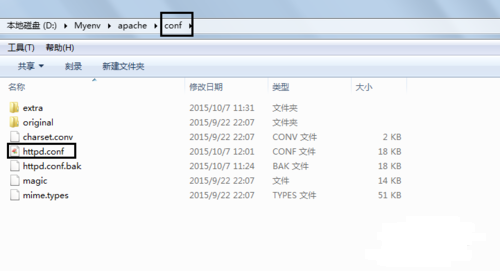
Here I will briefly explain the above code. The whole code means to let apache load the php processing module (LoadModulephp5_module). The "~php installation path" in the code changes according to the location where you install php. For example I installed it in the D drive, so my path is: D:Myenvphp-5.3.5 (note that the diagonal bar here is a reverse diagonal bar "", which needs to be changed to a forward diagonal bar "/" in the code), the code The place to join is to add it under a lot of LoadModules in httpd.conf, as shown in the figure below:

Then you need to check whether there is this file "php5apache2_2.dll" in the directory you just added. In theory, it should be there. Just in case, you must check it. This file is very important and serves as a bridge. .
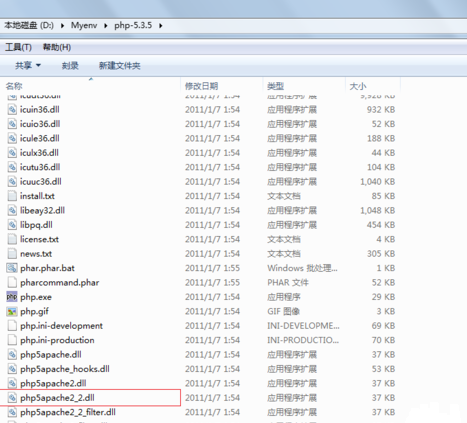
Next step we need to specify the PHP initialization directory, that is, the code "PHPIniDir '~php module installation path'". This code is used to specify the ini file of php, which will configure php. In layman's terms, you need Tell apache where to put your php. In the same way, we replace the "~php module installation path" in the code with the installation path just now

Then I will explain to you the meaning of the last line of code. The sentence "AddTypeapplication/x-httpd-php.php.phtml" means to add the application type. To explain in vernacular, it means that when *.php appears file, php will start processing the file. You can add comments to the configuration file to facilitate your own understanding, as shown below:

So, there are two places where we need to change the path. Mark the part in red in the picture below. Just change the red part to the path where you actually installed PHP (note the forward slope)

In addition, the php file settings are also very important. Find the php.ini-development file in your php installation directory and change its suffix name to php.ini. The reason for changing this is: our php settings need to be in php.ini modification. As shown below: Just delete the dark blue part of the name.

After the modification, the file will look like this, as shown below:

Now we need to specify the corresponding function module in php.ini. The specific method is to change the following code "
extension_dir="php extension library path" is added to the php.ini file you just modified. The purpose of this is to be able to use various powerful libraries of php, and the "php extension library path" has an "ext" folder under the folder where you installed php. Open this folder and it will contain php. Extension library. As shown below:
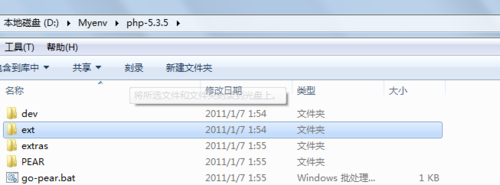
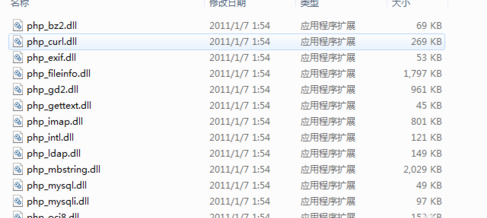
Now let's add the extension library path. Use your notepad to open the "php.ini" file and find the "extension_dir" location. You can use search to quickly locate the location. As shown below:
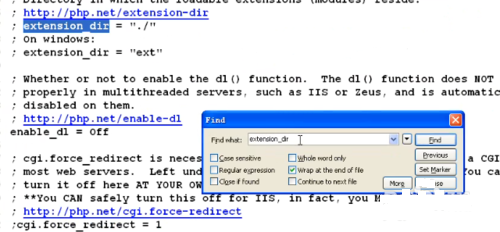
Then replace the location "extension_dir='ext'" with the path of your php library. Taking mine as an example, my library path is: D:/Myenv/php-5.3.5/ext (also note that it is correct Slant bar), as shown below: Replace the blue part with your library path.

The final replacement result is as shown below:

Now our integration has been completed and we can test whether it is successful. Test method: Call a simple php function, the function code is as follows:
<?php phpinfo(); ?>
Then restart your apache to see if it can be used.

If you integrate successfully, you will be able to see the shocking effect below.
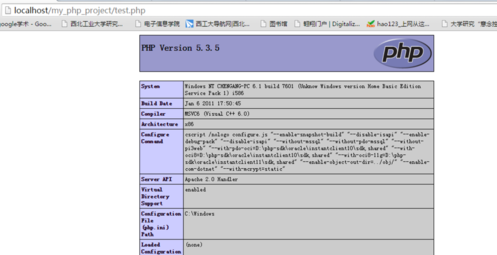
How to integrate apache and PHP? After reading the above, everyone’s ideas will be clearer. If you are satisfied with this article, please give it a like

Hot AI Tools

Undresser.AI Undress
AI-powered app for creating realistic nude photos

AI Clothes Remover
Online AI tool for removing clothes from photos.

Undress AI Tool
Undress images for free

Clothoff.io
AI clothes remover

Video Face Swap
Swap faces in any video effortlessly with our completely free AI face swap tool!

Hot Article

Hot Tools

Notepad++7.3.1
Easy-to-use and free code editor

SublimeText3 Chinese version
Chinese version, very easy to use

Zend Studio 13.0.1
Powerful PHP integrated development environment

Dreamweaver CS6
Visual web development tools

SublimeText3 Mac version
God-level code editing software (SublimeText3)

Hot Topics
 1663
1663
 14
14
 1420
1420
 52
52
 1313
1313
 25
25
 1266
1266
 29
29
 1237
1237
 24
24
 PHP's Purpose: Building Dynamic Websites
Apr 15, 2025 am 12:18 AM
PHP's Purpose: Building Dynamic Websites
Apr 15, 2025 am 12:18 AM
PHP is used to build dynamic websites, and its core functions include: 1. Generate dynamic content and generate web pages in real time by connecting with the database; 2. Process user interaction and form submissions, verify inputs and respond to operations; 3. Manage sessions and user authentication to provide a personalized experience; 4. Optimize performance and follow best practices to improve website efficiency and security.
 PHP: Handling Databases and Server-Side Logic
Apr 15, 2025 am 12:15 AM
PHP: Handling Databases and Server-Side Logic
Apr 15, 2025 am 12:15 AM
PHP uses MySQLi and PDO extensions to interact in database operations and server-side logic processing, and processes server-side logic through functions such as session management. 1) Use MySQLi or PDO to connect to the database and execute SQL queries. 2) Handle HTTP requests and user status through session management and other functions. 3) Use transactions to ensure the atomicity of database operations. 4) Prevent SQL injection, use exception handling and closing connections for debugging. 5) Optimize performance through indexing and cache, write highly readable code and perform error handling.
 PHP and Python: Different Paradigms Explained
Apr 18, 2025 am 12:26 AM
PHP and Python: Different Paradigms Explained
Apr 18, 2025 am 12:26 AM
PHP is mainly procedural programming, but also supports object-oriented programming (OOP); Python supports a variety of paradigms, including OOP, functional and procedural programming. PHP is suitable for web development, and Python is suitable for a variety of applications such as data analysis and machine learning.
 Choosing Between PHP and Python: A Guide
Apr 18, 2025 am 12:24 AM
Choosing Between PHP and Python: A Guide
Apr 18, 2025 am 12:24 AM
PHP is suitable for web development and rapid prototyping, and Python is suitable for data science and machine learning. 1.PHP is used for dynamic web development, with simple syntax and suitable for rapid development. 2. Python has concise syntax, is suitable for multiple fields, and has a strong library ecosystem.
 Why Use PHP? Advantages and Benefits Explained
Apr 16, 2025 am 12:16 AM
Why Use PHP? Advantages and Benefits Explained
Apr 16, 2025 am 12:16 AM
The core benefits of PHP include ease of learning, strong web development support, rich libraries and frameworks, high performance and scalability, cross-platform compatibility, and cost-effectiveness. 1) Easy to learn and use, suitable for beginners; 2) Good integration with web servers and supports multiple databases; 3) Have powerful frameworks such as Laravel; 4) High performance can be achieved through optimization; 5) Support multiple operating systems; 6) Open source to reduce development costs.
 PHP and Python: A Deep Dive into Their History
Apr 18, 2025 am 12:25 AM
PHP and Python: A Deep Dive into Their History
Apr 18, 2025 am 12:25 AM
PHP originated in 1994 and was developed by RasmusLerdorf. It was originally used to track website visitors and gradually evolved into a server-side scripting language and was widely used in web development. Python was developed by Guidovan Rossum in the late 1980s and was first released in 1991. It emphasizes code readability and simplicity, and is suitable for scientific computing, data analysis and other fields.
 PHP's Impact: Web Development and Beyond
Apr 18, 2025 am 12:10 AM
PHP's Impact: Web Development and Beyond
Apr 18, 2025 am 12:10 AM
PHPhassignificantlyimpactedwebdevelopmentandextendsbeyondit.1)ItpowersmajorplatformslikeWordPressandexcelsindatabaseinteractions.2)PHP'sadaptabilityallowsittoscaleforlargeapplicationsusingframeworkslikeLaravel.3)Beyondweb,PHPisusedincommand-linescrip
 PHP vs. Python: Use Cases and Applications
Apr 17, 2025 am 12:23 AM
PHP vs. Python: Use Cases and Applications
Apr 17, 2025 am 12:23 AM
PHP is suitable for web development and content management systems, and Python is suitable for data science, machine learning and automation scripts. 1.PHP performs well in building fast and scalable websites and applications and is commonly used in CMS such as WordPress. 2. Python has performed outstandingly in the fields of data science and machine learning, with rich libraries such as NumPy and TensorFlow.



